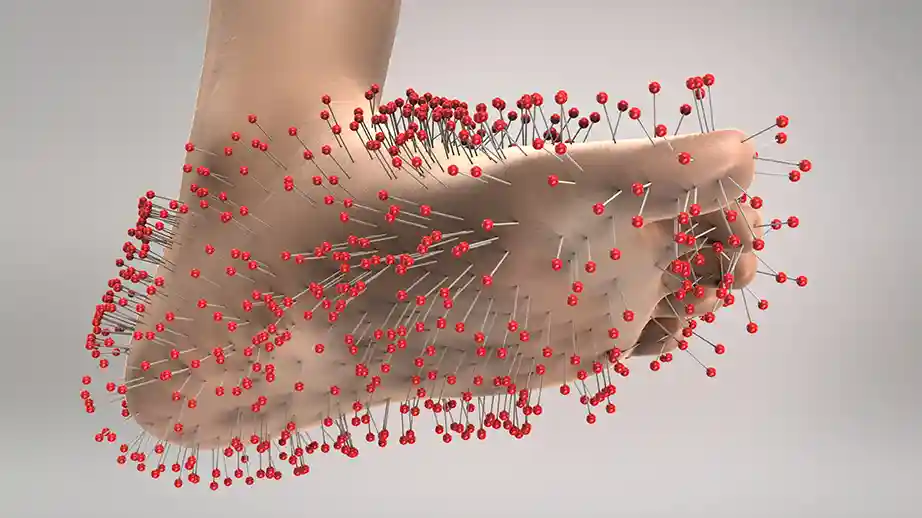6 Remedies for Tingling in Hands and Feet
From long car rides to awkward sleeping positions or hours hunched at a desk, daily habits can lead to that all-too-familiar tingling sensation (also known as paresthesia).1 It usually affects your hands, legs, or feet and feels like sharp pins and needles. Most of the time, these sensations are caused by compressed, irritated or damaged nerves that send out signals they shouldn’t.
If this happens to you often, don’t worry—there are ways to help ease the discomfort and keep it from occurring. Here are a few tips to help you out.
- Mind Your Position
Whether sitting, standing, or lying in an awkward position, simply repositioning your body can help relieve pressure on compressed nerves and improve circulation.2 Stretching your arms, wiggling your fingers and toes, and adjusting your posture can give your body a quick reset.
At night, your sleep position matters too.3 Sleeping with clenched fists can stress the median nerve, so aim to keep your hands flat and relaxed, ideally resting on a pillow.3 Side sleepers should support the entire arm with a pillow, keeping the elbow slightly bent and the wrist in a neutral position.3 Back sleeping is ideal, with your arms at your sides or supported on pillows.3
- Move and Exercise
Studies have shown that consistent aerobic activity helps preserve both motor and sensory nerve function, especially in people with conditions like diabetes.4 In one study, people who exercised regularly were far less likely to develop nerve problems than those who didn’t.4 Research also suggests that aerobic exercise may help damaged nerves regenerate, improve nerve signal speed, and even increase IENF branching (tiny fibers found in the skin) in diabetic individuals.4
- Massage the Area
Dealing with tingling and nerve pain daily? Complementary treatments might be worth exploring. Practices like acupuncture, massage, and tai chi have been shown to support pain management.5
You might also try TENS therapy, a noninvasive option that uses a mild electrical current to stimulate nerves through pads placed on your skin.5 It’s often used to reduce pain in areas where nerves are pinched and compressed. However, it is still advisable that you consult a healthcare provider before trying TENS therapy, especially if you have certain medical conditions.
- Heat and Ice Pads
Try alternating between ice and heat packs. Ice helps reduce the swelling, while heat boosts blood flow and relaxes tight muscles around the nerve. 6 Together, they improve circulation and may ease your discomfort.
Try this: apply an ice pack to the affected area for about 15 minutes, three times a day to calm inflammation. Follow up with a heat pack for up to an hour, also three times daily, to help loosen muscles and encourage healing. Protect your skin by wrapping packs in a towel and never apply heat right after injury or when swelling is severe.
- Improve Work Ergonomics
Whether you're at a workstation, or doing detailed manual tasks, proper posture and movement habits can help reduce nerve compression, muscle strain, and long-term discomfort. Here’s how to stay aligned and protect your body:7
- Keep your spine and muscles relaxed by adjusting your position every 10–15 minutes.
- Avoid tight grips. Use a light hold on tools or instruments. Alternate hands when doing repetitive tasks, and use all your fingers—not just your thumb or index—when squeezing to spread the pressure evenly.
- Try to keep your neck as neutral as possible (no more than 15° forward tilt).
- Place monitor screens about 1 meter away, slightly angled downward (0–15°) to reduce neck strain
- Adjust your work surface so your elbows bend naturally between 90° and 120°. This position helps keep your back straight and shoulders relaxed.
- Consider Nerve Supplements
If tingling or “pins and needles” is something you feel often, it might be worth looking into nerve-supporting supplements.8 Along with proper diet and regular exercise, B vitamins are known to support healthy nerve function and may help reduce nerve irritation or damage.8 Consider Vitamin B1+B6+B12 (Pharex® B-Complex)!
Vitamin B1+B6+B12 (Pharex ® B-Complex) contains the right levels of vitamins B1 (100mg), B6 (5mg), and B12 (50mcg)—essential vitamins that help prevent neuropathy symptoms like pangangalay, pamamanhid, and tusok-tusok.9
Not only does Vitamin B1+B6+B12 (Pharex® B-Complex) support nerve health, but it also helps give the energy boost needed for daily activities to help you stay active, stay healthy, and stay Pharexcited every day!
When should you take Vitamin B1+B6+B12 (Pharex® B-Complex)?
It is recommended to take one (1) to two (2) tablets of Vitamin B1+B6+B12 (Pharex® B-Complex) daily, or as prescribed by a physician. Refrain from taking more than the recommended dose and taking the supplement after the expiry date indicated on the label.
Note: Vitamin B supplements are generally safe when taken within recommended dosages. It is important to be mindful of potential interactions, individual tolerance, and the need for personalized guidance based on specific health conditions.
If symptoms persist, consult a doctor.
References:
- Content - Health Encyclopedia - University of Rochester Medical Center. (n.d.). https://www.urmc.rochester.edu/Encyclopedia/content?ContentTypeID=1&Co ntentID=58
- 5 ways sitting is killing your nerves - Neuropathic Therapy Center | Loma Linda University Health. (2025, March 5). https://lluh.org/services/neuropathic-therapy-center/blog/5-ways-sitting-kill ing-your-nerves
- Ryan. (2022, December 8). Sleep positioning and nerve compression syndromes - Occupational therapy services. Occupational Therapy Services. https://otservices.wustl.edu/sleep-positioning-and-nerve-compression-synd romes/
- Dobson, J. L., McMillan, J., & Li, L. (2014). Benefits of exercise intervention in reducing neuropathic pain. Frontiers in Cellular Neuroscience, 8. https://https://pmc.ncbi.nlm.nih.gov/articles/PMC3983517/
- Peripheral neuropathy. (n.d.). National Institute of Neurological Disorders and Stroke. https://www.ninds.nih.gov/health-information/disorders/peripheral-neuropathy
- Ice Packs vs. Warm Compresses For Pain. (2024, September 19). Johns Hopkins Medicine. https://www.hopkinsmedicine.org/health/treatment-tests-and-therapies/ice -packs-vs-warm-compresses-for-pain
- Ergonomics - Overview | Occupational Safety and Health Administration. (n.d.). https://www.osha.gov/ergonomics
- Baltrusch S. (2021). The Role of Neurotropic B Vitamins in Nerve Regeneration. BioMed research international, 2021, 9968228. https://doi.org/10.1155/2021/9968228
- Vitamin B1+B6+B12 (Pharex® B-Complex) Product Information Leaflet. Date of Revision April 2023.
Let your circle know about this article

In 1987, Pharex then shifted to marketing and distributing generic products, while appointing Metro Drug as its exclusive brand distributor. This move proved to be timely because of the passing of the Generics Act of 1988. Many successful years followed, and in 2016, Pharex was acquired by RiteMED Inc. Even after more than 35 years in the industry, Pharex remains committed to empowering Filipino families by providing them with top-notch healthcare solutions.
More on Pharex here27th Floor Greenfield Tower, Mayflower St. Corner Williams St., Highway Hills, Mandaluyong City
For other questions, please contact us at (02) 7971-3333 or at productsafetyph@pharexhealth.com





